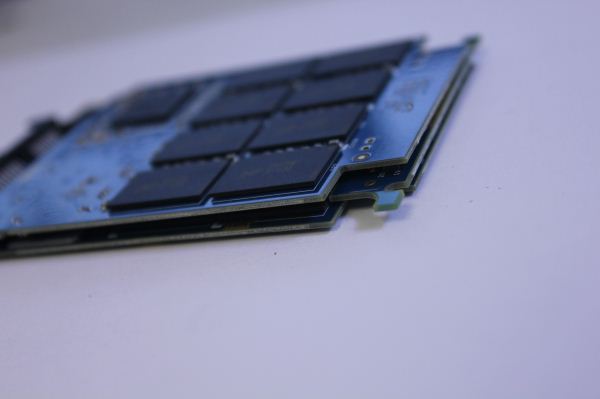OWC Mercury Electra 3G MAX 960GB Review: 1TB of NAND in 2.5" Form Factor
by Kristian Vättö on October 18, 2012 1:00 AM ESTFinal Words
The 960GB Mercury Electra is definitely a niche product and I can only see one scenario where it can easily be justified: you have a laptop or other computer with very limited storage capabilities and you want an SSD with as much capacity as possible. In any other case, it will be cheaper and more sensible to use hard drives or multiple SSDs. Desktop users should have absolutely no need for 1TB SATA SSDs because all of Intel's and AMD's recent desktop chipsets (except Intel H61) come with six native SATA ports. Even if one of the ports is used up by the optical drive, there are five left, which gives you 2.5TB of SSD space if you put a 512GB SSD in every port. If that's not enough, $30 will buy you a PCIe SATA card with two ports and give you 1TB more SSD storage. Depending on your motherboard, you may be able to add several PCIe cards, so only the sky is the limit here.
Laptops usually have only one 2.5" hard drive bay (though it may be possible to add another one by removing the optical drive), which significantly limits the storage options. Externally you can add terabytes of storage but if your usage requires mobility, you will want to avoid carrying any extra devices as much as possible. When you're limited to having only one 2.5" drive, making the decision between an SSD and a hard drive can be difficult if you need a lot of storage. With SSDs, you get speed but pay a premium and are limited to 512GB with a few exceptions. Hard drives are slow but cheap and available in bigger capacities. Where the 960GB Electra makes sense is if you need more than 512GB of space and SSD-level IO performance.
However, the need for speed is a must. A 1TB 2.5" hard drive costs around $100, which is over $1000 less than what the 960GB Mercury Electra currently costs. You must really be able to benefit from the increased IO performance to justify spending that much on a drive. Normally I don't find comparing hard drives and SSDs to be very reasonable but the Mercury Electra is not the fastest SSD. Random IO performance is obviously better, but not as much as it could be since that is the biggest weakness of the Mercury Electra. Sequential throughput can be over twice as fast compared to a similar size 2.5" hard drive but that is only a twofold increase, whereas the increase in price is over tenfold.
Another important aspect to remember is power consumption and battery life: the 960GB Mercury likes electrons, a lot. At idle it draws around as much power as most SSDs draw under full load, and power consumption under load is among the highest as well. It's likely that the 960GB Mercury will shorten your battery life compared to a hard drive or other SSDs, which should be kept in mind if the drive is put into a laptop.
While the 960GB Mercury Electra is not a revolutionary product, it's great to see OWC putting out yet another unique product. Most SandForce SSD OEMs are way too similar: all have two or three SSDs with different NAND and form factor. There is no real differentiation. OWC is at least trying to be different and catering markets that others aren't (for example replacement SSDs for MacBook Airs), and the 960GB Mercury Electra is yet another fruit of that.
The only things I would want from the 960GB Mercury Electra are SATA 6Gbps support and higher random read/write performance. At over $1000, there is a significant premium in terms of price per GB compared to 512GB SSDs and you're only getting SATA 3Gbps—and not even good SATA 3Gbps performance, really. Then again, we are talking about a niche product with no real competitors, so the people who want such a product should be ready to pay the premium.











36 Comments
View All Comments
geoffty - Saturday, October 20, 2012 - link
"If we go a year back in time, you had to fork off around $1000 for a 512GB SSD"It's "fork out", not "fork off". That just sounds rude. :-)
Donkey2008 - Saturday, October 20, 2012 - link
SandForce/LSI (Milpitas, CA)OWC (Woodstock, IL)
Micron (Boise, ID)
USA! USA! USA!
Kristian Vättö - Tuesday, October 23, 2012 - link
It's made in the US.adriantrances - Sunday, October 21, 2012 - link
250MB speeds + Sandforce + 1100$ + OWC = GGGood luck selling that.
Luscious - Monday, October 22, 2012 - link
How can you talk 9 pages about a SSD and not mention the z-height? Many notebook/netbook drive caddies won't fit a 9.5mm device.Kristian Vättö - Tuesday, October 23, 2012 - link
It's 9.5mm like most 2.5" drives are. Usually I don't mention the height unless it's thinner (or thicker) than the usual 9.5mm. Most laptops use 2.5" 9.5mm drives, although some thinner models have started to adopt 7mm drives (especially Ultrabooks and other SSD only laptops).